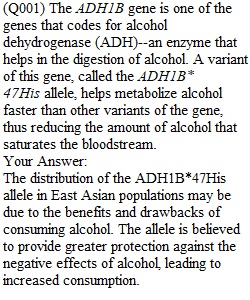


Q Question 1 1 / 1 pts (Q001) The ADH1B gene is one of the genes that codes for alcohol dehydrogenase (ADH)--an enzyme that helps in the digestion of alcohol. A variant of this gene, called the ADH1B*47His allele, helps metabolize alcohol faster than other variants of the gene, thus reducing the amount of alcohol that saturates the bloodstream. It also causes a negative side effect, where a person's face flushes red when he or she consumes alcohol. This allele is rarely found in African or European populations, but it is very frequent in East Asian populations, where it is often found in more than 50% of the population and may even be found in almost 100% of people in certain populations. These East Asian populations also have a history of growing rice and making fermented rice beverages that extends as far back as 12,000 years before the present (BP). The map on p. 248 (Lab 08 Exercise 8) of your lab manual shows the frequency of the ADH1B*47His allele in East Asia. Sites where evidence of rice cultivation has been found are superimposed on the map. Given what you know about the evolutionary forces behind human variations, how would you explain the distribution of the ADH1B*47His allele? Why do you think this allele is common in East Asian populations? Do you see a relationship between rice cultivation and allele frequency? Hint: Consider the benefits and drawbacks of consuming alcoholic beverages and how this might factor into the evolution of the ADH1B*47His allele.
View Related Questions